This is a Minolta XE-7, a 35mm SLR camera produced by Minolta Camera Co. between the years 1974 and 1977. The XE-7 was sold exclusively in the United States as it was called the XE and XE-1 in Japan and Europe respectively. The XE-7 was the product of a joint agreement between Minolta and Ernst Leitz GmbH, to share patents, know-how and product development, on a variety of projects. The XE-7 is built on the same platform and shares many of the same parts with the Leica R3 including a custom Copal CLS vertically traveling focal plane shutter. The XE-7 was an expensive camera that fit in one step below Minolta’s professional level X1/XK/XM and featured aperture priority automatic exposure and a few modern features missing from Minolta’s top of the line SLR. The XE-7 is still a favorite of collectors and users alike for it’s excellent build quality, Leica history, and ease of use.
Film Type: 135 (35mm)
Lens: 50mm f/1.4 Minolta MC Rokkor-X PG coated 7-elements
Lens Mount: Minolta MC Bayonet
Focus: Variable
Viewfinder: Fixed SLR Pentaprism with Split Image and Microprism Focus Aides
Shutter: Copal CLS Electronic Vertically Traveling Focal Plane
Speeds (Automatic): 4 – 1/1000 seconds, stepless
Speeds (Manual): B, 4 – 1/1000 seconds, 1/90 mechanical with shutter on “X” with no battery
Exposure Meter: 2x CdS Cells TTL w/ viewfinder needle and Aperture Priority AE
Battery: (2x) 1.5v LR44/S76 Silver Oxide Battery
Flash Mount: Hotshoe and FP and X Flash Sync, 1/90 X-sync speed
Weight: 1076 grams (w/ lens), 767 (body only)
Manual: https://www.cameramanuals.org/minolta_pdf/minolta_xe-7.pdf
How these ratings work |
The Minolta XE-7 is one of the greatest Minolta cameras ever made and one of my all time favorites. Made at the dawn of the electronic age when cameras were still stout and robust, the XE-7 is like a classic 1960s SLR but with 1980s technology. The camera was good enough to be the basis for the Leica R3 and combined with any number of Minolta’s excellent lineup of Rokkor lenses, this is a very capable camera that is often overlooked today and can be picked up for cheap. Highly recommended! | ||||||
| Images | Handling | Features | Viewfinder | Feel & Beauty | History | Age | |
| 2 | 2 | 2 | 2 | 2 | 1 | 0% | |
| Bonus | +1 for one of the best 35mm SLRs ever made, the complete package | ||||||
| Final Score | 12.0 | ||||||
History
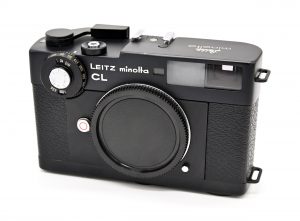
In the years since the release of the Minolta XE-series, it has garnered a reputation as a Leica/Minolta hybrid camera, but that’s not entirely true. While yes, in 1974 when Minolta released the XE in Japan, they had an agreement with Leitz to produce the Leitz/Minolta CL series, the XE was entirely built by Minolta, for Minolta.
The partnership between Leitz and Minolta began in 1972 with the intention of releasing an all new compact 35mm rangefinder using the Leica-M mount. Leitz had been producing the Leica M-series since 1954 and had a limited capacity to create an all new camera model. Minolta had the production capability and desire to release their own premium compact camera, so the partnership was created to the benefit of both companies.
The Leica CL and Minolta CL were released in April and November 1973 respectively to a positive reception. Although only a few lenses were developed specifically for the CL-series, almost every M-mount lens was compatible for it, save for a few special purpose lenses. An estimated 35,000 Leica CLs were sold in it’s first year, not counting any Minolta branded models with a total production of about 65,000 units. The cameras were discontinued only 3 years after their release, because their lower cost was having a negative impact on Leitz’s more expensive M-series.
Although the CL-series was successful, the market for premium rangefinders was getting very small as photographers heavily favored the Single Lens Reflex. The need to develop an SLR was not lost on Leitz and like nearly every other company, in 1964 they developed their own model, the Leicaflex.
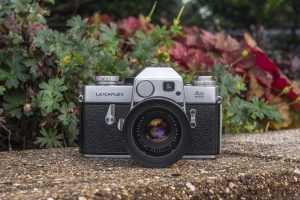
The original Leicaflex was a big and heavy camera built to the highest quality standard, but it lacked many features that other companies had been including in competing SLRs. In 1968, an updated model called the Leicaflex SL made it’s debut with TTL metering, open aperture metering, an improved viewing screen, and a few other upgrades.
The Leicaflex SL was very expensive to sell, and even more expensive to build. It is commonly believed that Leitz lost money on every SL that was sold, and with limited sales, they would never recoup the total cost of development and manufacturing. In order for them to stay profitable, Leitz was forced to turn to their partner for help.
The Minolta XE (this was it’s Japanese name, it was called the XE-1 in Europe and XE-7 in North America) had been on the market since 1974 and Leitz looked to it’s high build quality and modern technology as the ideal platform for their next generation of Leitz SLR. In 1976, the Leica R3 was released which was heavily based on, but not exactly the same as the Minolta XE. Unlike the Leica and Minolta CL cameras in which both are nearly identical in function and feature, the R3 would improve upon the Minolta camera by including a superior metering system and a different lens mount. Also unlike the CL-series which was entirely built in Japan, the Leica R3 was built in Wetzlar, Germany and later in a Leitz factory in Portugal.
Lenses made for the Leica R3 are not compatible with the Minolta XE as not only is the bayonet different, but the method in which the body communicates with the lens was changed to accommodate the Leica’s more advanced metering system. Leitz offered factory conversions for earlier Leicaflex lenses, and later in the 1980s some Minolta made lenses were produced with the R3’s mount, but to my knowledge, no unmodified Minolta lenses would ever work on the R3.
Both the Minolta XE and Leica R3 were successful, but as SLR technology rapidly evolved in the mid 1970s with newer models favoring smaller, more compact designs and having more advanced auto exposure systems, their relevance in the market quickly disappeared. In 1977, Minolta would discontinue the XE, replacing it with the XD7/XD11. Leitz would continue production of the R3 until 1979 at which time they would release the R4 which was also built in collaboration with Minolta.
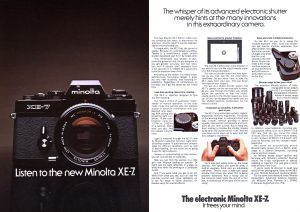
When it was on sale, the Minolta XE7 sold body only for $485, or with the f/1.4 or f/1.2 lenses for $645 and $720 respectively. These prices when adjusted for inflation compare to $2300, $3075, and $3425 respectively, making it quite the investment for the advanced amateur. For those who couldn’t quite afford so much for a camera, in 1975 Minolta would release an economical version of the XE-7 in the US only, called the XE-5 which retained the same shutter and metering modes but with a more basic viewfinder, multiple exposure mode, film transport indicator, and a few other features. If you could live without those features, the XE-5 could be purchased with a 50mm f/1.7 Rokkor lens for $499.
Minolta positioned the XE-7 below their professional X1/XK/XM and above their more commercially friendly SRT series as a semi professional model loaded with technology and built to a quality standard above other cameras.
The press took notice of the XE-7 and lauded it’s build quality, technology, and smoothness. The following three articles appeared in various 1975 issues of Popular Photography and Modern Photography magazines. The overall consensus was that this camera was an impressive release by a company who hadn’t previously compete in the advanced amateur 35mm SLR market.
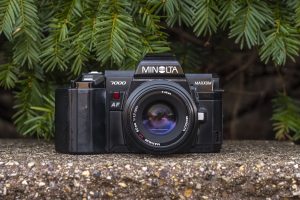
In 1977, the XE-7 would be replaced by the XD-7 and XE-11 which further added new technology, adding both shutter and aperture priority auto exposure modes, new Silcon Photo Diode exposure meters, and an electro-sensitive shutter release that would only power the meter when it detected the presence of the photographer’s finger.
Minolta’s emphasis on including as much technology as they could into their upper level SLRs would continue into the 1980s with the release of the X-700 and eventually the first consumer 35mm SLR with in body auto focus, the Maxxum 7000. Each of these cameras would be revolutionary in their own way, incorporating features that weren’t yet common in competing brands.
Today, Minolta SLRs are popular among collectors and shooters alike, and with such a large range of models to shoot from, the XE-7 usually isn’t the most common choice when the question of Minolta’s best SLR comes up. But when it does, the people who do recommend it are usually passionate. The XE-7 hit that perfect balance of a heavy weight, full sized, professional quality SLR, but with technology and conveniences of cameras that were more common after it.
My Thoughts
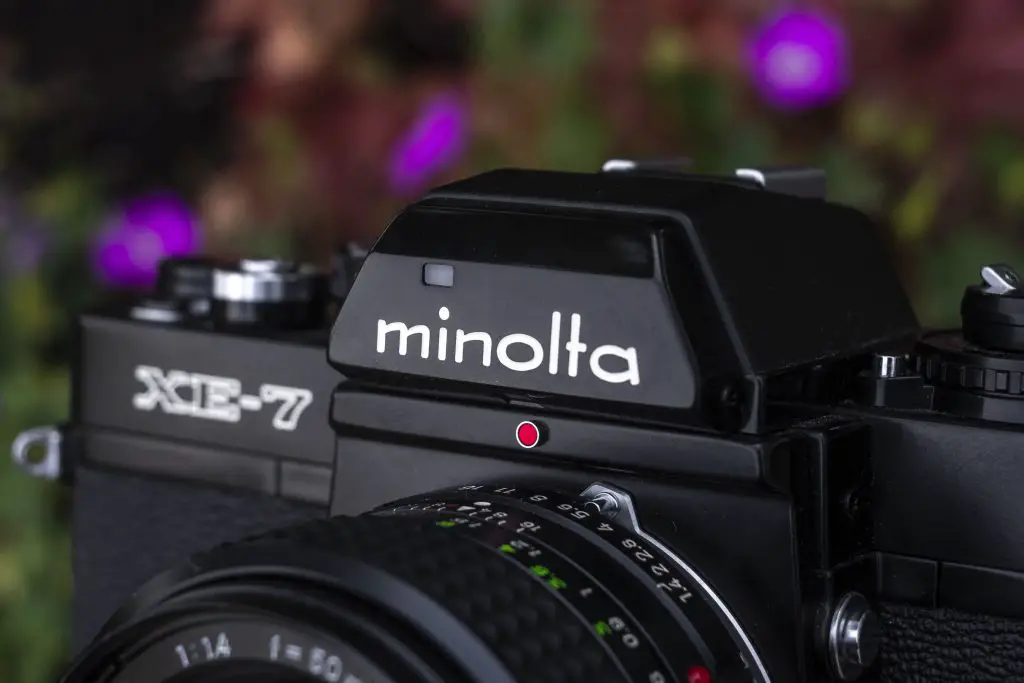
It’s been almost three years since my last manual focus Minolta SLR review for the Minolta SR-7, but that doesn’t mean I have been neglecting Minolta SLRs. Like I’ve said a number of times when referring to Nikon SLRs, these cameras are so good, and so common, it’s very difficult to come up with a thorough review that isn’t just me repeating what everyone else has already said.
Then one day, while talking to my good friend James over at Casual Photophile, he mentioned the Minolta XE-7 was one of his first camera reviews and remains still one of his favorite models and I thought that maybe it was time for me to take a look.
The Minolta XE-7, along with it’s other name variants, is a bit of an anomaly in Minolta’s SLR line-up as it’s still a large body SLR but it has an electronic shutter. It’s most direct competitors would be the Canon EF and Nikon EL2 in that all three models predate each company’s switch to more compact cameras, each had an electronic Copal shutter, auto exposure, and all were very expensive when new.
With the Rokkor-X 50mm f/1.4 lens attached, the XE-7 weighs a not insignificant 1076 grams (2.34 lbs) which means that it might not be my first choice for a camera I plan on hanging from my neck during a long hike through the woods. Of course with that heft comes confidence and durability as the XE-7 has the feel of a very refined instrument that later Minolta SLRs lacked.
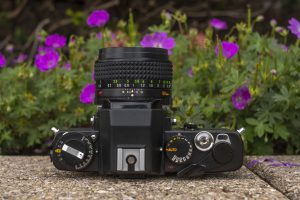
The top plate shares more in common with classic SLRs from the 1960s than electronic ones of the later 70s and that’s perhaps one of the biggest reasons the XE-7 is such a dependable camera, as there’s less to go wrong.
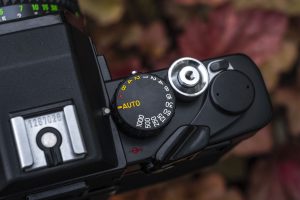
Every control is where you expect it from the rewind crank and combined +/- exposure / ASA dial on the left, fixed pentaprism with flash hot shoe in the center, to fully mechanical shutter speed with with speeds 4-1000 plus B, X, and Auto to the large cable threaded shutter release and comfortable rapid film advance lever. The shutter speed dial has a lock that engages when the camera is in Auto which requires you to press a small button to rotate it away from that setting. The shutter release has a built in shutter lock that is engaged any time the camera is switched off to prevent accidentally exposure.
Above the rapid advance lever is something that looks like a black plastic button, but this is actually a lever that allows you to defeat the double exposure prevention and allow you to take multiple exposures on the same piece of film. To use it, with one finger, move it as far to the right as it will go and then move the film advance lever to cock the shutter without advancing the film. I actually had to look this up in the XE-7’s manual to figure this out as I’m sure many owners of this camera don’t know what this does either!
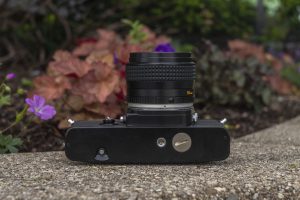
The bottom of the camera features the rewind release button, centrally located 1/4″ tripod socket, and the round cover for the battery compartment. A notable omission is a connection for an external motor drive which is a feature that a professional might have wanted if they were to consider the XE-7 as a backup to Minolta’s pro-level X1/XK/XM.
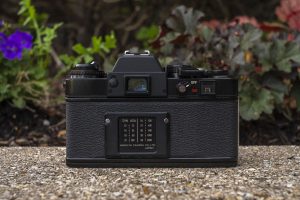
To the left of the viewfinder eyepiece is a blackout curtain switch which is useful for keeping stray light from entering the prism and giving a false reading when doing long exposures or when the camera is on a tripod away from your eye.
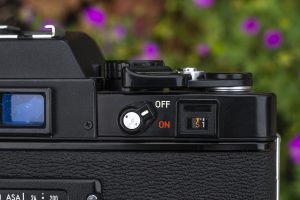
To the right is the camera’s on/off switch, automatic resetting exposure counter, and above it a clever little film transport indicator. Without film in the camera, this window is black, but when film is correctly transporting onto the take up spool, a red bar should be visible. Like the viewfinder blackout curtain and multiple exposure lever on the top plate of the camera, this is another small detail of the camera that elevates it from a lesser model.
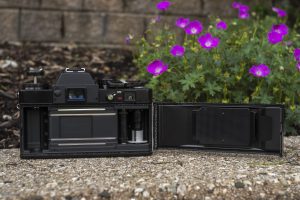
Opening the film compartment requires an upward tug of the rewind knob. The right hinged back reveals a modern left to right film compartment. The vertical metal blades of the Copal CLS shutter can be seen here, along with a double slotted, fixed take up spool. Film winds onto the take up spool clockwise which is said to help improve flatness as the film travels across the film plane. You’ll also notice that in the image to the right, the camera still has it’s original degraded light seals. The white specks are a sure fire way to tell the seals need to be replaced, which I later did before shooting the camera.
The film pressure plate is an oversize metal plate with divots that helps to reduce resistance as the film passes across it it. If you look closely, another nice feature of the camera is that the pressure plate sits into a recess in the film gate. Notice the two curved corners above and below the film gate that match the shape of the pressure plate. When the camera is closed, the pressure plate sits securely in this recess, improving stability while film is transported within the camera.
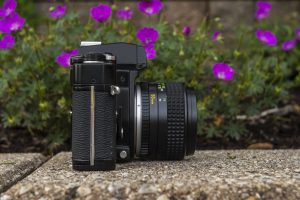
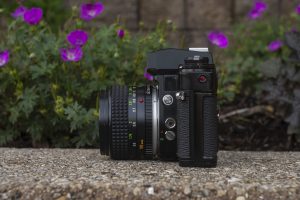
The sides of the camera aren’t without their small details as well. For starters, the XE-7 has front angled metal strap lugs which are oriented in a way where when the camera hangs from your neck, it will not tilt forward like some cameras do.
On the right side of the mirror box, is a depth of field preview button which you can press to manually stop down the lens while composing the image.
On the mirror box’s left side, you can see the lens release button, PC flash socket, and a switch to select between FP and X-flash sync. On the side of the body is a red battery check light with a lever surrounding it to activate the light. Another power-related feature of the camera is that when the XE-7 detects a low voltage from the battery either due to expired batteries or when shooting in very cold situations, the mirror will lock in the up position to prevent incorrect exposure due to insufficient power to the shutter and meter. If this happens, the mirror can be reset by turning the shutter speed dial to either B or X.
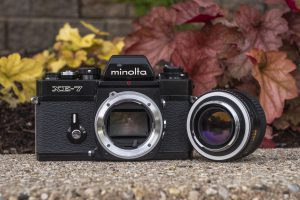
Like every Minolta SLR dating back to the SRT-101, the XE-7 has the MC-bayonet mount which automatically indexes the lens allowing for accurate meter coupling of the chosen aperture size. The XE-7 works fine with later MD mount lenses and the earlier SR lenses (although without the meter coupling) meaning that there is a huge selection of lenses made before and after the camera which will work on it.
To the left of the lens mount is the self timer lever which operates a little different from those found no other SLRs. For starters, you’ll notice two white marks to on the collar around the lever. These are marks that when rotated fully, give a 10 second delay before firing the shutter, and 6 seconds for the other mark. The self-timer is infinitely variable, so delays between 6 and 10 seconds and even less than 6 seconds are possible.
But where the self-timer is different, is that with the self-timer set, the shutter release button does not activate the delay. This is accomplished by a small button that is behind the self-timer handle. Once you rotate the handle, this button becomes visible and when pressed, begins the countdown. Unlike other cameras that once the self-timer is set, it must be used, with the XE-7, you can set the self-timer and still fire the shutter normally using the shutter release without a delay.
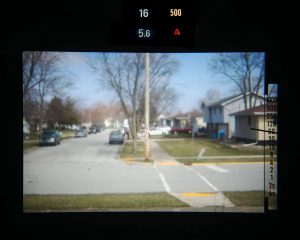
The viewfinder is nice and bright and I had no problem seeing the full image wearing prescription glasses. While shooting the XE-7, I also had access to a Minolta XK and when using the same exact lens, I found the XE-7’s viewfinder to be slightly brighter, especially near the corners. Both cameras have a Mat-Fresnel viewing screen, so I am unsure why the XE-7s was better, but it was.
On the right side is an analog scale for the exposure meter. Like most cameras of the day, this scale gets it’s light from light that enters through the lens, so it is very hard to read indoors or in low light situations. The meter works whether the camera is in Auto or manual mode. Above the visible viewfinder are two indicators, the one on the left is the selected f/stop on the lens as seen through a small “Judas window” beneath the prism, and the one on the right the selected shutter speed (or ‘A’ for Auto) on the shutter speed selector.
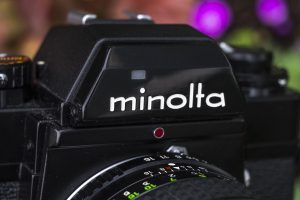
In the viewfinder image above, I show a composite image of the viewfinder in both manual (f/16 @ 1/500) and auto (f/5.6 @ A) modes. In reality, only one pair of numbers can be seen at a time. This is useful though because in Auto mode, you can see your selected f/stop along with the shutter speed the camera will use when you fire the shutter. In Manual mode however, you can both see your selected shutter speed, along with the one the meter recommends. It is up to you whether you want to select the recommended shutter speed, or choose your own.
What I like the most about the Minolta XE-7 is that on one hand, it feels like a no nonsense old school 1960s mechanical SLR, but it also has quite a few modern features like an infinitely variable electronic shutter, auto exposure, a full information viewfinder, and several other neat features that the older SLRs don’t have. All of it’s buttons and switches are mechanical giving a feeling of robustness, and while I can’t say that I’ve handled a ton of XE-7s, based on my limited experience and those of other collectors I’ve spoken to, these are often found in working condition, unlike some later Minolta SLRs that die due to failed capacitors or other electronic gremlins.
The excellent combination of old school style and build quality with modern electronic conveniences gives the camera an excellent feeling of balance. It is this balance which I think is it’s greatest strength. The XE-7 could very well be my favorite Minolta SLR, but how does it shoot?
My Results
I took the XE-7 out for it’s inaugural roll in late summer 2019 and loaded it with fresh Fuji 200 color film. I enjoyed shooting the camera so much, I wanted to wait until I had a chance to shoot it again later that year, but I never got around to it.
Eventually, in March 2020 during the COVID-19 quarantine, I decided to load up a roll of my favorite black and white film, Kodak Panatomic-X. This particular roll had expired in 1977, so it was nearly as old as the camera. Having prior experience with old Pan-X, I knew this film likely would still shoot close to box speed. I set the meter on the XE-7 to ASA 20 and left the meter on Auto and let it do it’s thing.
As should probably be a surprise to no one, the images I got from the XE-7 were outstanding. Minolta was a premiere lens maker and anything they ever made with the name “Rokkor” on it is going to produce great images, so of course everything is sharp and clear without any of the usual optical anomalies seen in lesser lenses.
What’s more notable about the images I got from the XE-7 was the ease at which I was able to get great shots with little effort. In the case of the black and white images, I was shooting 40+ year old Kodak Panatomic-X that I shot hand held inside of a grocery store and they came out nice. The shots of the birds are in direct sunlight, and most of the other shots are done on an overcast day, yet the metering system on this also 40+ year old camera was up to the challenge. Thankfully, by the time Minolta released the XE-7, they had stopped using 1.35v mercury batteries, so the metering system in the XE-7 relies on easily found 1.5v silver oxide and alkaline batteries. This means there is no voltage variance which could throw off the meter.
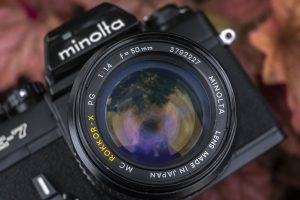
I intentionally shot both rolls of film with the camera in Auto as I think that’s more a test of the camera’s capability than any type of manual guessing I could have done, but I have complete confidence that had I wanted to externally meter, I would have gotten just as great of shots.
I think that’s the best compliment I can give this camera. The XE-7 is a large hulking camera reminiscent of classic SLRs from the 1950s and 60s. With a weight of over two and a quarter pounds (with the Rokkor 50/1.4 lens) this is not an insignificant camera to have dangling from your neck. Based solely on it’s size, you would be forgiven if you thought this was a rudimentary early SLR without any modern conveniences. Yet the camera is as effortless to shoot as those who came decades after it. The XE-7 is a camera that can be whatever you want. A full sized old school manual everything camera, or a modern point and shoot SLR whose only requirement is your ability to manually focus your images.
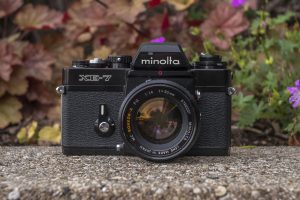
I often struggle to write reviews of excellent cameras because I feel like all I can do is gush over them. It’s so much easier to come up with things to say about cameras that are difficult to use or don’t produce good images, and that’s a shame because there are cameras like this Minolta XE-7 that in some ways, represent the best of what film photography is about.
Earlier in this review, I talked about how the Minolta XE-7 was the basis for the Leica R3, and the second you mention the “L-word” to any film camera enthusiast, thoughts of German precision and quality dance in their heads, but for me, the suggestion that Ernst Leitz improved upon this camera is a disservice to how great it is. The Minolta XE-7 is a Minolta, through and through, and that’s not something to be ashamed about!
It is my favorite Minolta SLR and one that I’ve already come back to many times, and hope to many more times in the future. I think that if you tried one, you’d agree.
Related Posts You Might Enjoy
External Links
http://camera-wiki.org/wiki/Minolta_XE
https://www.casualphotophile.com/2014/04/14/minolta-xe-7-slr-a-casual-retrospective/
http://www.alexluyckx.com/blog/index.php/2018/10/10/ccr-review-98-minolta-xe-7/
http://satnam.ca/cameras/minoltaxe/xemain/xemain.html
https://www.678vintagecameras.ca/blog/x-marks-the-spot-the-minolta-xe-series
https://www.visibleinlight.com/cameras/minolta-xe-7/
https://tinkeringwithcameras.blogspot.com/2016/02/minolta-xe-1.html

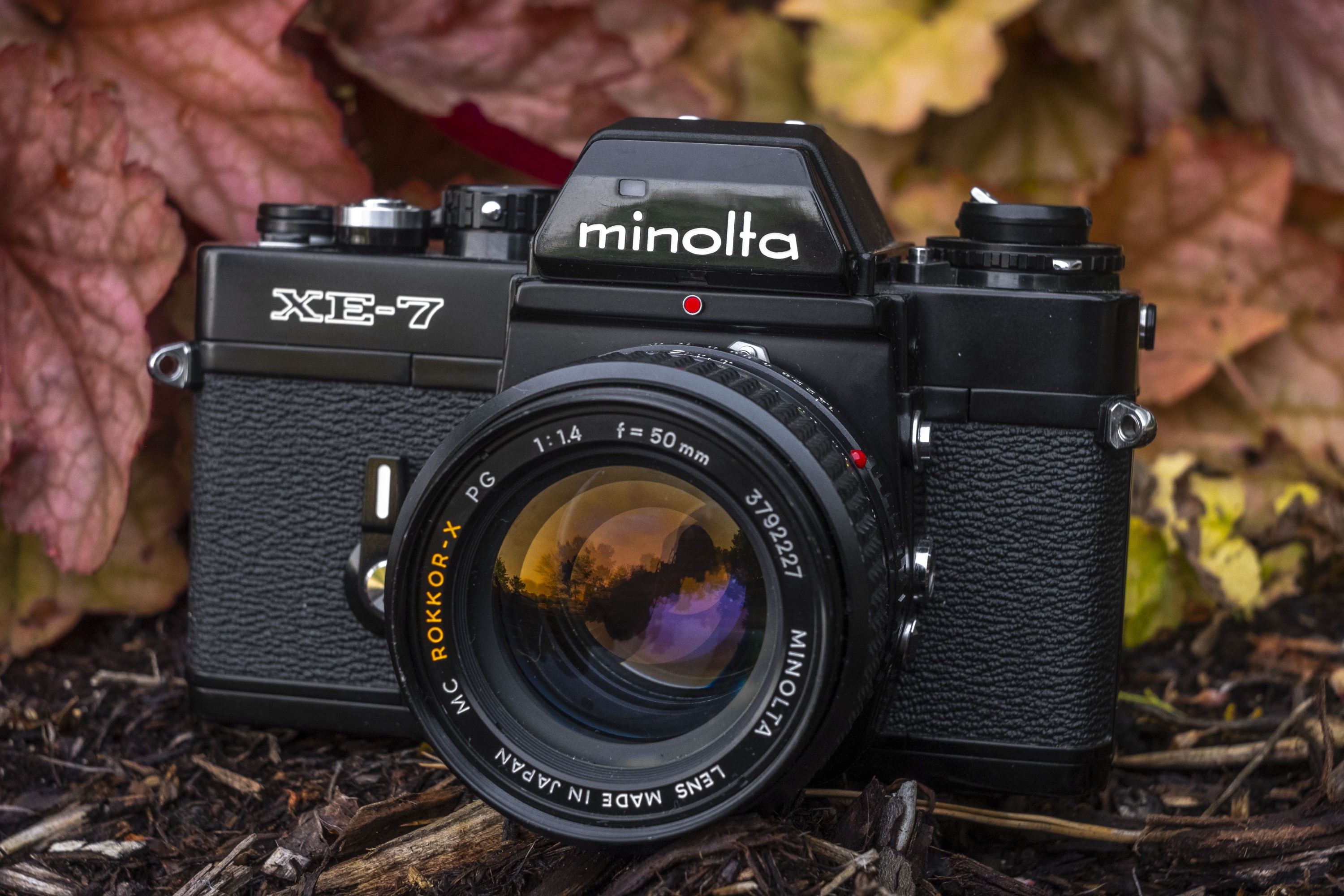
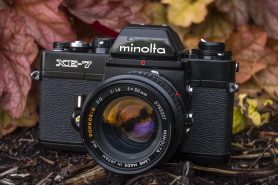
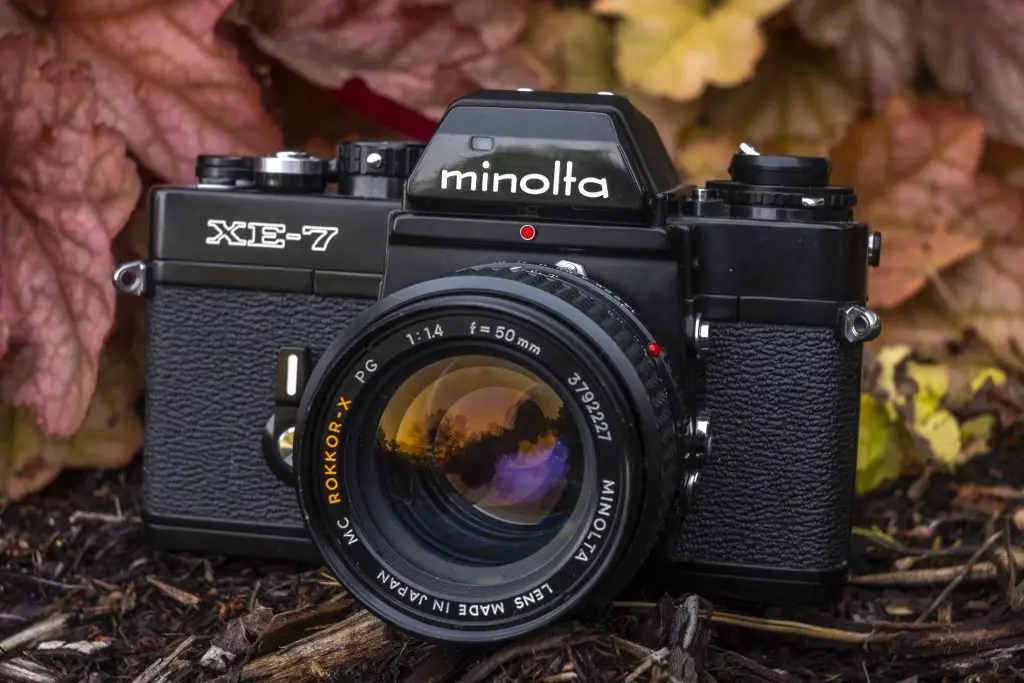
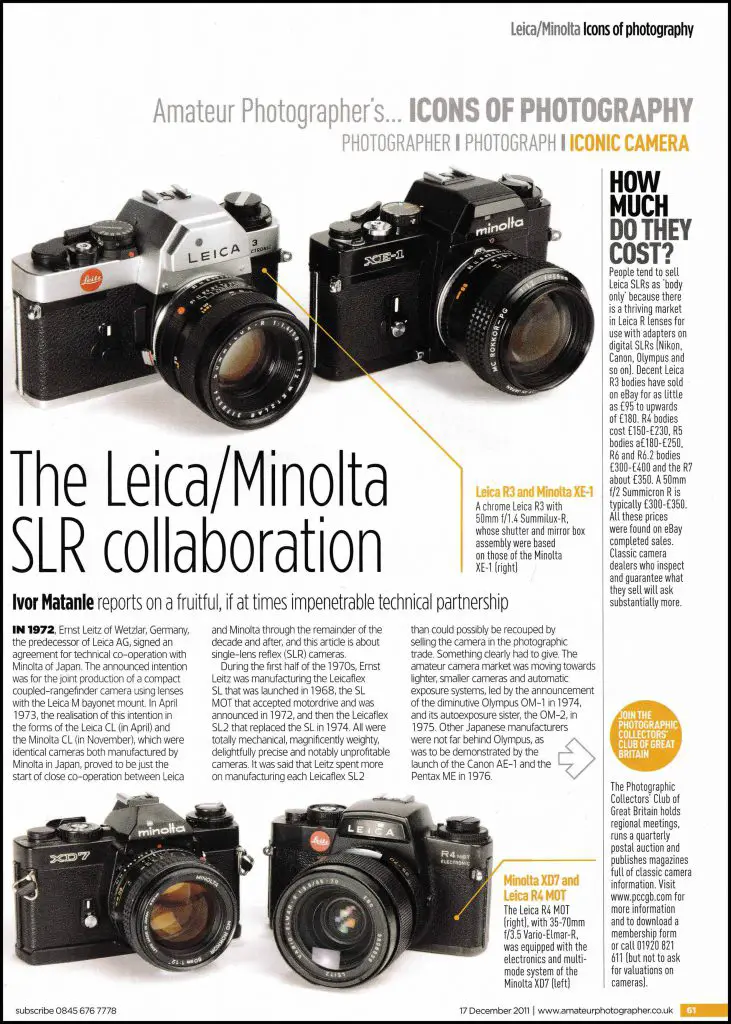
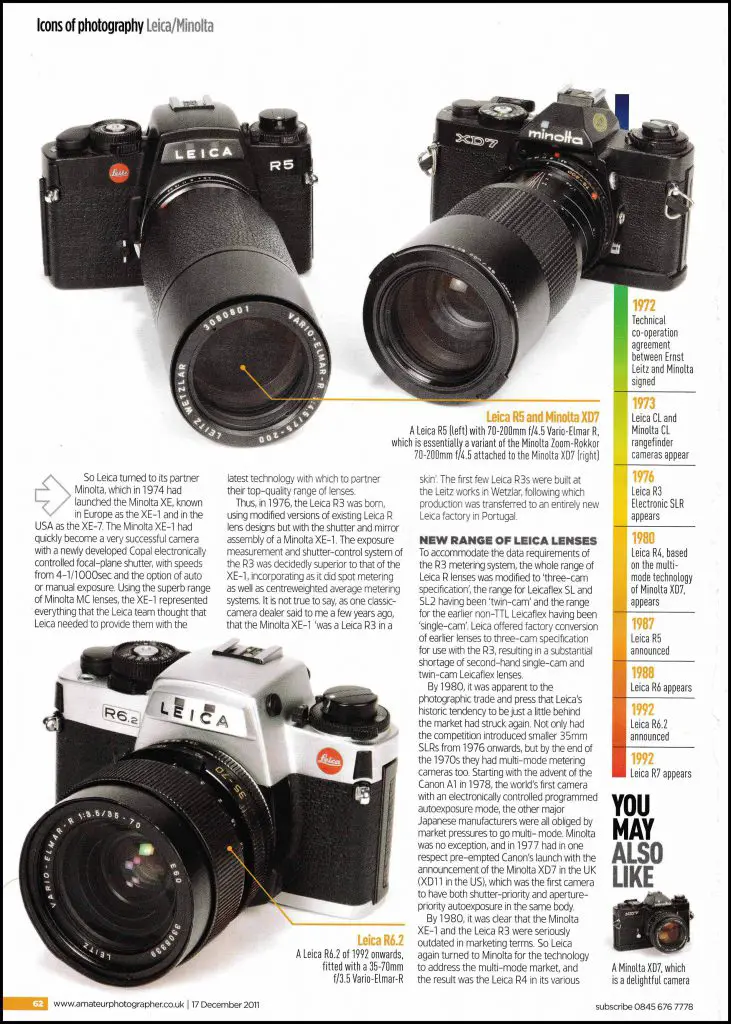
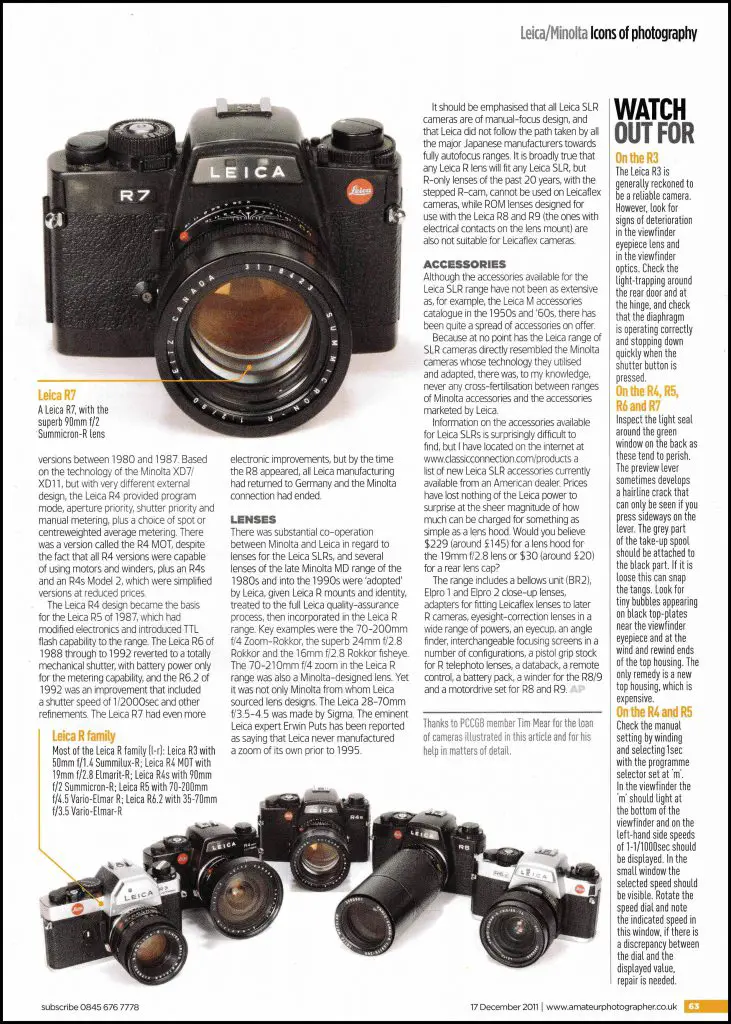
























Ahhh — to have a working model! I got two of these through shopgoodwill.com — which is always a crapshoot — and unfortunately they are rather broken — the winding mechanisms on both do not function — beyond my repair capacity. Unfortunately a guaranteed working version is too much money for my budget!
Another great review. I have been unlucky with Minolta’s and the three copies of this model I have are all inoperative in various ways, but I do have a working XE-5. That is one smooth and elegant camera. I love Minolta lenses and have persevered with the broken bodies to be able to shoot them with film.
Yup — I have amassed a number of this generation — XG-7s, XG-9s, XG-Ms — and so far like only 1 out of 5 work reliably enough to use. About 1/2 have stuck shutters/advance and those where the shutter does work, the meter/exposure control is not working reliably or accurately. SIGH
Guess I am lucky. Have two XE-7, one XE-5, two XG-M, one XD-5, and two XD-11 which all work fine. I do have two XD-11 bodies that have issues but were presented that way and I bought to try my hand at repairing as I have a great series of articles on it in a photographic repair magazine of the time.
tmb3fan — darn! You are lucky! 🙂 Now I have not (so far) purchased a Minolta SLR that was guaranteed to be working — I have been getting mine from shopgoodwill dot com — and I have found that unfortunately less than 50% of the vintage cameras that I get work completely/correctly. Luckily I have not paid a ton for anything. But I did just get an XG7 that seems to be mostly working (shouldn’t the light meter in the viewfinder display something when I am manually setting the shutter speed? It works when set to A, but nothing other than that)….
Hi, Dana. Sorry about this being several months late. Your Minolta XG-7 metered shutter time won’t show in manual mode. A working metered manual mode for the XG-series didn’t arrive until the XG-M in 1981. As for your stuck shutter(s), a bad shutter release capacitor is probably to blame. I’m no repairman, but you might be able to get that serviced. I’m an old Minolta lover and am also seeking out working Minolta gear, manual- and autofocus. Goodwill is a great organization, and I applaud you for supporting them, but chances are, any electronic equipment found there is liable to be nonfunctional. I’m scouring Amazon and used camera stores online for second-hand equipment, and recently found a fantastic Minolta 80-200mm f/2.8 APO for my digital Sony, and am deciding between an XE-7 or an XD-11. Aw, heck, I’ll probably get both ! Best of luck with your search ;>)
Thank you so much for this post. I’ve been lucky enough to inherited my step-father’s XE-7, and though I had used it briefly in HS for photography class (Way back when they let us in a darkroom to play with chemicals and film), I really don’t have much experience with it. In the past, I’ve picked it up a few times to take with me traveling, but it’s so heavy. However, you’ve convinced me to try again. Everything seems to be working, and your post has shown me bells and whistles my step-dad never mentioned to me. (To be fair, I was a teen when he tried to teach me. It probably went in one ear and out the other.)
I am glad you enjoyed the post. The XE-7 is a fantastic camera and although it is heavy, with a good neck strap, I am sure you’ll forget about it in no time!